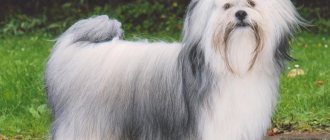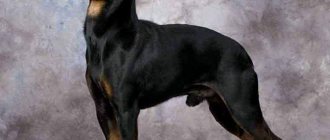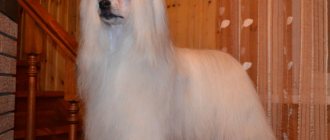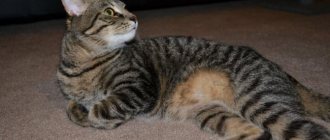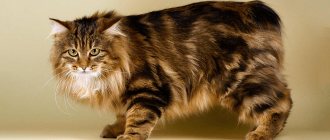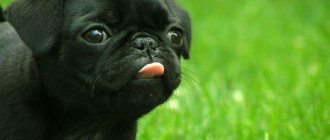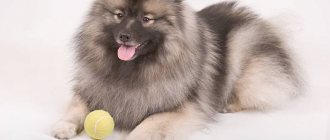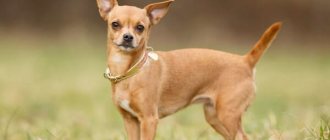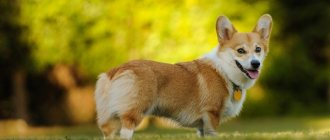The Weimaraner is considered a true aristocrat of the canine world. The dog has an absolutely unique set of hunting qualities, remarkable intelligence and is immensely devoted to its owner. In addition, the dogs have an amazing and unusual coat and eye color, which leaves no one indifferent who saw such a dog for the first time. From this article you will learn how to properly raise a Weimaraner, what you need to prepare before bringing a puppy into your home, what to feed and how to care for such a pet.
History of the origin of the breed
It is not known for certain whether the breed is ancient. Mention of similar dogs can be found in a chronicle from the 13th century. It is believed that similar animals could already be found at the court of the French king Louis the Saint. Presumably, several gray dogs were brought by him from Egypt.
The fashion introduced by the sovereign was quickly supported at court. Soon not a single aristocratic house could do without such a dog. Subsequently, the fashion for Weimaraners spread to other yards in Europe.
A clearer and more down-to-earth version of the origin says: the hunting dog was bred in Germany in the 19th century. Initially, huntsmen studied the German breed, selecting individuals most suitable for gun hunting. The breed got its name from the area where the first representatives appeared - the city of Weimar.
Since many people were interested in the graceful dogs, the first fans of the breed appeared, and systematic selection began. Representatives of other breeds were not involved in crossing. Since 1890, purebred breeding of the Weimar pointer began. Pure blood has been maintained for over a century.
Photo: wikimedia.org
History of the Weimaraner breed
photo can be enlarged
The first Weimaraner breed standard was written in 1896, the official standard was developed in Germany in 1925, and it was registered with the FCI in 1969.
But in fact, the story of the appearance of this dog is shrouded in mystery and is rooted deep in history. There are different versions of the origin of these dogs.
In the Middle Ages, such dogs were mentioned in ancient manuscripts. Some documents from that time talk about Saint Louis's dog, which resembled a modern Weimaraner.
The French king Louis IX, better known as Louis the Saint (1214-1270), was captured in Egypt during a crusade around 1248. After he returned to France, he got a pack of gray dogs, which were called: the dogs of Saint Louis - Chiens gris de St-Lois. In Russian hunting literature, L.P. Sabaneev mentions them under this name.
The most famous work of the Middle Ages is the “book of hunting” written by Count Gaston de Foix (1331-1391). It describes in detail the gray dogs of Saint Louis. There are tapestries depicting hunting scenes of the nobility of that time with these dogs. Images of gray dogs can be found in works of art from the seventeenth century. Van Dyck's paintings dating back to 1631 show gray dogs very similar to the Weimaraner.
The success of these dogs was such that by the end of the fourteenth century, many noble people in France kept gray dogs, which were certainly used for hunting large animals: deer, wild boar, bear. Later, when the number of animals became smaller, these dogs began to be trained to hunt birds.
Other royal courts in Europe followed the example of the French. Because of their elite status, the Weimaraner's ancestors were highly valued and were always with their owner. Apparently, this constant contact with humans for almost 8 centuries has instilled in the Weimaraner the need to always be close to a person; he cannot live separately, for example in an enclosure, like other hunting dogs, and the Weimaraner suffers greatly from this emotionally.
The breed called the Weimaraner was first mentioned in the 1850s. The document says that the breed developed in East Germany in the vicinity of the city of Weimar. These dogs were very popular at the court of the Grand Duke of Weimar. This is where the name of the breed comes from.
photo can be enlarged
There is a photograph from 1871 showing the young Baron Wintzigerode Knor with his Weimaraner named "Nord". In 1880, dogs of this breed first participated in an exhibition in Berlin (Germany), where they were classified as crossbreeds.
The Duke of Weimar (Germany), Karl August, wanted to create a multifunctional breed. It is assumed that to complete his plan, he infused the Weimaraners with the blood of several other dog breeds. He wanted to create a dog that could work at speed, work efficiently, and have endurance, so that this dog could also be good for hunting in the field and as a companion at home. The Weimaraner is called the "Silver Ghost" not only for its coloring, but also for its ability to be fast, using an almost cat-like ability to sneak through fields, combined with a silent, almost ghostly working style.
In 1896, a commission of delegates finally recognized the Weimaraner breed as an independent breed. Now this breed was no longer classified as a crossbreed. Meanwhile, the German Weimaraner Club was founded by several amateur hunter sportsmen. These people wanted to breed dogs only for hunting, not for sale. Therefore, the rule was adopted that no one could buy a dog of this breed without first becoming a member of the club.
This has led to the fact that it has become difficult to buy a Weimaraner even in Germany, and almost impossible outside its borders. Now the situation in Germany itself has practically not changed; there, as before, the performance qualities of the Weimaraner are at the forefront, sometimes, unfortunately, to the detriment of the exterior. However, this breed can already be purchased quite freely abroad; the main thing is to know where dogs with good working qualities and excellent conformation are bred.
Description of the breed
The Weimaraner is a large dog with power and regal bearing, an athletic build and high intelligence. Dogs live, on average, about 10-14 years. But much will depend on the conditions in which the dog is kept, diet, care and the presence of hereditary diseases.
Dogs that hunt regularly have a longer life expectancy.
Weimar Pointer puppies have azure-colored eyes and are so cute and attractive that few can resist mini Weimaraners.
Varieties
Its coat gives the breed a special charm. In addition to the amazing color, short-haired dogs have a coat so smooth and shiny that it seems as if the dog has been doused with liquid silver. This effect is created due to the fact that the undercoat is almost completely absent, and the outer coat itself is smooth and durable.
There is also a long-haired variety of the breed. The hair length of such dogs reaches 5 cm, there is a small undercoat. The outer hair is soft and has a slight wave.
The rarest type of Weimaraner is the straight-haired. Such dogs simultaneously have a fairly thick undercoat, and the outer coat itself is smooth and durable, and does not curl.
Colors
The most common color is gray, with shades ranging from silver-blue to mouse-like. It is acceptable to have small white spots on the chest and paws. The presence of red tan marks is possible; this will not be considered a defect in the breed, but such an individual will not be valued too highly at an exhibition.
A serious color fault will be the presence of brown markings. The dog's skin has a flesh tone.
Representatives whose color is different from gray shades are subject to disqualification. For example, black, copper or any other.
Breed standard
The breed standard was formed after the first exhibitions. This happened at the beginning of the 20th century.
Standard:
- Dimensions: ideal height for males is 63-67 cm at the withers, but individuals with a height of 59 to 70 cm are allowed for breeding. For females, these values are: ideal 59-63 cm, height from 57 to 65 cm is considered normal;
- Weight: males from 30 to 40 kg, females from 25 to 35 kg;
- The head should be in balance with the height and face. In males it is wider than in females. There is a median groove on the forehead;
- The nose is dark flesh-colored. Gradually fades to gray towards the rear;
- The muzzle is almost rectangular in shape, powerful;
- Strong jaws, scissor bite;
- The eyes should be amber in color, ranging from dark to pale. Puppies have azure eyes, gradually changing color as they grow older;
- Eyelids are rounded;
- Drop-shaped ears. The tips of the ears should reach the corner of the mouth;
- The tail set is lower compared to similar breeds. When at rest the tail is lowered, when excited it is in a horizontal position;
- The skin is strong, but not rough;
- The limbs are high, well developed and muscular.
Photo: wikimedia.org
What is the difference between the breed
The Weimaraner is not suitable for all animal lovers in the house, as it has many undeniable advantages:
- Aristocratic character, expressed in unhurriedness and grace;
- Ability to protect their masters;
- Perfect sense of smell;
- Willingness to serve people (will allow them to be used as service dogs in the police, Ministry of Emergency Situations);
- Large sizes (height up to 70 cm; weight up to 40 kg);
- Higher level of intelligence, excellent memory, independence, easy learning;
- Friendliness, allowing you to get along with other dogs and be patient with children.
But there are also shortcomings, which are expressed in excessive persistence, expression of stubbornness and exactingness.
Similar breeds
There are several hunting breeds that can be confused with the Weimar Pointer.
Hungarian pointer
The Hungarian Vizsla is a hunting breed whose representatives have an excellent sense of smell and excellent trainability. The first mention of the breed dates back to the 10th century.
The breeds are very similar to each other, but the Vizsla is characterized by a golden-red color.
Photo: pixabay.com
Kurzhaar
An excellent hunter, distinguished by endurance, fast running and power. Outwardly it has many similarities with the “silver ghost”. But his body is not so muscular, but rather sinewy and lean.
There are many color options for the shorthaired pointer; the standard identifies six types. This is mainly a combination of colors: beige and liver. The color is heterogeneous, with many inclusions.
Photo: pixabay.com
Silver Labradors
Labrador is a breed that has long and firmly won the hearts of people. However, the Labrador was originally a hunting breed. There is no point in comparing him to the Weimaraner. Outwardly they have nothing in common.
The craze for mating dogs of various breeds has become a real fashion. This is done with the aim of obtaining unusual mestizos that cause a stir among buyers. One of these mixed breeds was the silver Labrador.
So far, such individuals have not been identified as a separate breed, but those wishing to buy a purebred German pointer should be careful. There is a high risk of acquiring a mixed breed, one of whose parents may be a Labrador Retriever.
Photo: thelabradorsite.com
The second version of the origin of Weimaraners
In fact, it is not known for certain how and when these dogs appeared, but there is no doubt that such animals were present at the German court of Karl August, Duke of Weimar in the 19th century. They say that the nobleman himself dreamed of creating a new universal hunting breed that would be distinguished by endurance, courage, lightning-fast reaction and selfless devotion to its owner.
Seeing the almost catlike grace of the dog, suddenly turning into a swift rush towards its prey, German hunters called it the “Silver Ghost”. Subsequently, in Weimar for a long time these amazing animals were called that way.
Character and behavioral characteristics
First of all, it is worth noting that the dog absolutely cannot stand being alone. She needs constant contact with a person. It will not be possible to send the dog to its place and not communicate with it if the owner is at home. He, of course, will carry out the command, but will be deeply unhappy.
The breed needs constant movement and a variety of activities. Otherwise, the hyperactive dog will not lose energy and will begin to misbehave.
If there is no opportunity or desire to hunt, you will have to come up with a lot of other active activities so that the dog shows maximum physical activity during a walk.
The Weimaraner's excellent hunting instincts in the city can play a bad joke on him. In places where the dog is in danger (near the road, for example), it is necessary to keep it strictly on a leash.
The breed gets along well with other animals. They get along well with children, becoming nannies and security guards.
Look how he watches the cat!
A character trait is irritability. It directly depends on the activity of the animal. The owner is quite capable of removing the irritability factor. Just walk and play with your dog as often as possible.
Training and education
From the first days of arrival in the house, the puppy must go through the process of socialization. You shouldn't hide it from all people and dogs. The animal must be accustomed to the sounds of the city and to the behavior of other pets in the house (if any). At a young age, the Weimaraner needs to be trained to wear a collar by putting it on the baby puppy for a while every day. If the Weimaraner participates in hunting, some skills may be learned at an early age.
Weimaraners are highly trainable if the owner teaches them good behavior from an early age. To successfully master Weimaraner commands, you should not overload and punish. If a dog is purchased as a companion, then the completed General training course can easily turn the animal into a well-mannered and obedient friend. A hunting dog must accompany its owner during outings from the age of 4-5 months. Weimaraner hunters are trained from childhood so that the dog learns all the intricacies of hunting. In cases where the Weimaraner owner does not plan to participate in hunting with the dog, sufficient loads should be selected in terms of any dog sport.
Education and training
Raising a Weimaraner is a real pleasure. Even the most inexperienced owner can do this. Dogs simply love any activity with a person. Possessing a developed intellect, they love to learn new things and quickly master all basic commands even at a very young age.
Here is an example of training a puppy, take a look!
https://www.youtube.com/watch?v=1evvYK12Ku8
The main condition for classes is to conduct them regularly, acting persistently and confidently. Physical force and psychological pressure must not be used. Do not forget that this is a serious and very strong dog.
No matter how successful you are in education and training, remember that the hunting instinct can force an animal to chase what it perceives as prey. Use a leash in the city.
Training tips:
- Teaching a puppy commands begins from the first day: accustoming to a nickname, the commands “no” and “come”;
- Be sure to socialize your dog, otherwise it will become timid and fearful;
- You can take your baby hunting as a cop from the age of six months. At an early age, a passion for hunting manifests itself; training in poultry and game will help the dog quickly master skills and become disciplined;
- Preparing a good hunter is a troublesome task. If you are not confident in your abilities, it is better to consult a specialist.
Here is a Weimaraner on the hunt.
Appearance
Unfortunately, most ordinary people can only admire the Weimaraner in photographs. An untrained eye will confuse the breed with a strange-colored shorthaired pointer, and there is some logic in this. All German gun dogs are of the same type, at least similar in face. However, if you are considering purchasing a puppy, it is worth reading the detailed description of the breed.
The Weimaraner is a medium-sized hunting dog with a well-defined gender identity (reformism). Bitches are elegant, usually more refined and docile than males. There are several criteria in determining standard height and weight:
- Males: preferred height 62–67 cm; permissible height 59–70 cm; weight 30–40 kg.
- Females: preferred height 59–63 cm; permissible height 57–65 cm; weight 25–35 kg.
Breed standard
- The head is a moderately sized skull, proportional to the body. The back of the head is rounded, distinguished by a small tubercle (like in Setters or Shorthaired Pointers). The forehead is quite wide, divided by a furrow, and covered with folds of skin during work or a state of concentration. The cheekbones and eye sockets are well defined. The chewing muscles are well developed, and the eyebrows are actively involved in facial expressions. The transition of the forehead to the bridge of the nose (bridge of the nose) is moderate. The bridge of the nose is smooth, with a small hump at the very tip of the nose. Lips are tightened, without pronounced “jowls”. The pigmentation of the edges of the lips, gums and palate is flesh-colored (pink).
- Teeth – medium, strong, in full set. Scissor bite, without gap. The jaws are very strong and powerful. Due to the developed muscles, the grip is very strong.
- The nose is large and classically shaped. The tip protrudes slightly beyond the line of the lower jaw. Lobe pigmentation in a dark, liver palette. The color fades into gray, matching the fur on the bridge of the nose.
- The eyes are medium-sized, neat, round. The outer corner of the eye is raised towards the ear. The eyelids are dry, pigmented to match the coat or flesh. The color of the irises is in the amber palette; in puppies it is exclusively bright blue.
- The ears are large, triangular, well rounded, set high and relatively close (not so close that the forehead appears narrow). The ear cartilage is moderately soft. When at rest, the ears hang on the sides of the head, the tips at the level of the corner of the jaw. In a state of concentration, the ears are raised at the cartilage and turned forward.
- The body is a moderately elongated format, the ratio of the length of the back from the withers to the croup to the height at the withers is 12:11. The neck is rounded, of medium length with a good bend, thickens towards the shoulder girdle and smoothly passes into the withers. The withers are pronounced, the back is straight, moderately wide, the croup is well rounded at the transition to the hips. The chest is deep, but not wide, and does not interfere with a sweeping step while running. The keel is powerful and protrudes slightly. The ribs are moderately rounded, visually flat and elongated. The body is covered with elastic, moderately stretched skin.
- Limbs – the front legs are dry, long, even, placed under the withers. Hind legs with developed muscles and strong, harmoniously articulated joints. The pasterns, elbows and hocks are parallel to the body. The hands are gathered into a dense ball, the fingers are strong, curved with powerful claws. The pigmentation of the claws is gray. The paw pads are covered with elastic skin, pigmented in the basic color of the coat. Among the features of the breed, the structure of the front hands is distinguished - the middle finger is longer than the rest and visually stands out. This is in no way considered a fault, but dewclaws are undesirable and are removed during puppyhood.
- The tail is strong, thick, tapering to the tip. Set relatively low. In a calm state it carries low, and in an excited state it moves at the level of the spine or slightly higher. Does not bend, does not touch the back and does not fall over the croup.
Diseases
We can say that the breed is characterized by good health. Hereditary diseases occur, but they are much less common than in other breeds.
The Weimar Pointer has a tendency to:
- stomach problems and intestinal volvulus;
- parasitic infestations;
- joint diseases (hip dysplasia);
- extra eyelashes;
- dermatitis (between the fingers);
- demodicosis;
- melanoma, lipoma;
- cryptorchidism (undescended testicles).
Photo: flickr.com
Weimaraner or shorthaired pointer?
The Weimaraner (German: Weimaraner) or Weimar pointer is a hunting gun dog. Its ancestors were also used in hunting big game.
He is obedient and unusually intelligent, easily trained and reaps laurels in training competitions, used for investigative work and as a watchman.
The Weimaraner is native to Germany. Some Weimar natives call this dog the “silver ghost”. This breed has a very ancient history, presumably its ancestors are the European Braques. Initially, the Weimaraner was a hunting dog breed and coped with its duties perfectly, as it was fast, dexterous and smart. And although there is no confirmation of this fact, there is an opinion that the Duke of Weimar Karl August participated in the breeding of this breed. She was probably born at the beginning of the nineteenth century.
The Weimaraner is a dog of average or above average height, regular, proportional build, with beautiful lines and good handling qualities.
Height at withers
males 59-70 cm, preferably 62-67 cm females 57-65 cm, preferably 59-63 cm Weight
males 30-40 kg females 25-35 kg The color is silver-gray, like a roe deer in winter clothes, or mousey, as well as transitions between these shades. The head and ears are usually somewhat lighter. Small white markings on chest and paws are allowed. A more or less wide dark stripe often runs along the ridge. Weimar Pointers with a clearly visible tan can be used in further breeding work only if they have outstanding hunting qualities.
Coat
Shorthair type: Short (but longer and denser than most comparable breeds), very dense, smooth, well-fitting topcoat. The undercoat is absent or very sparse. Longhair type: Soft, long outer coat with or without undercoat. Smooth or slightly wavy. Short. The head is dry, proportional to the general build. Males are wider than females. The forehead is flat, divided by a straight groove, the transition from the forehead to the muzzle is barely noticeable. The occipital protuberance protrudes slightly. Cheekbones are clearly defined.
The muzzle is long, graceful, parallel to the line of the forehead, straight, sometimes with a small hump. The upper lip hangs moderately, covering the lower jaw and forming a small fold at the corners of the mouth.
The ears are hanging, wide and rather long, with rounded ends, set high and narrow, slightly turned forward when alert.
Nose. The nose is a dark “meat” color, gradually turning gray towards the back.
The eyes are round in shape, slightly slanted. Light to dark amber in color. Puppies are light blue in color.
The case is strong, slightly stretched in format. The neck is set high, strong, muscular. The withers protrude noticeably above the top line. The chest is wide and deep, reaching down to the elbows. The ribs are quite convex. The back is strong, muscular, and somewhat long. The croup is long, moderately sloping.
The tail is set quite high. At rest it hangs down. When moving, the dog carries it parallel to the ground. Docked between 1/2 and 2/3 of the length. Covered with abundant hair.
Limbs. The legs are dry, muscular, with correctly defined articulation angles. The shoulders are well formed and fairly long. Paws in a ball, without dewclaws. The fingers are arched; elongated middle fingers are not a fault.
A breed of dog such as the Weimaraner is a good and, most importantly, attentive student. Its representatives easily learn commands and how to carry them out. These are quite active and not at all aggressive animals. They easily find a common language with people and are very devoted to their owner. They are capable of showing tenderness, but they are also in a bad mood. They love outdoor games and walks, so it is best to take them outside the city, where there is space and at least relative freedom.
The Kurzhaar (German: Kurzhaar, from kurz “short” and Haar “hair”), or German Pointer, is a German short-haired pointer. Bred in Germany. The basis for the creation of the breed was the old German shorthaired pointers. A very active dog.
The closest relatives of the shorthaired pointer are the drathaar and langhaar.
The history of the German Shorthaired Pointer begins with dogs that were used for bird hunting with nets, especially in Mediterranean countries, as well as falconry. Through France, Spain and Flanders, pointers found their way to German estates. The most important distinguishing feature of these dogs was their ability to work in a standing position. After the appearance of the first double-barreled shotgun (1750), the need arose for a pointer for hunting while flying from under a dog. This was the beginning of the transition from a pure pointer to an all-purpose gun dog. A serious basis for the formation and development of the breed since 1897 was the “Studbook of the German Shorthaired Pointer”. Prince Albert of Solms-Braunfels compiled breed characteristics, evaluation rules and, finally, simple test rules for a hunting dog.
Today, the German Shorthaired Pointer still goes through the filter of breeding, breed improvement and testing. The standard provides for the physique of the shorthaired pointer as a universal hunting dog, which allows it to fulfill all the requirements associated with hunting, even at age.
The shorthaired pointer is a slender and even lean dog. This breed is considered large, with a maximum height at the withers of 66 centimeters. The dog's color ranges from almost black to café au lait. Puppies have fairly light fur; it darkens with age. The shorthaired pointer is a spotted dog, and the location of the spots can be very different. The most common color variations:
several large uneven spots scattered on the back, and the paws and belly look like scattered coffee beans; the dog is all brown, but the head has small spots; The dog is covered in dull, almost merged small spots. The shorthaired pointer is a hunting dog, or rather a pointing dog, that is, it takes a stance on birds and small animals. The shorthaired pointer is universal, works on all types of game birds. The shorthaired pointer performs best when hunting in the field. The Shorthaired Pointer swims well, is excellent at retrieving, and can be used as a bloodhound. He also has a fully developed protective instinct. In Europe, the Shorthaired Pointer is one of the most popular breeds used for hunting.
The shorthaired pointer is easy to spoil, as the dog is very smart and immediately determines who can indulge it.
Due to its dense and hard coat, it is practically not afraid of insects.
While searching and moving, it easily tolerates frost down to -20C. But it can catch a cold when transported in a sleigh or an open body, so after the hunt it is recommended to cover the dog with a cape or blanket. Two Shorthaired Pointers easily endure frosty nights down to -7C in the car.
Withstands work in cold, almost icy water. But after the hunt, the dog must be thoroughly dried and covered with a cape. When hunting for waterfowl or woodcock in the spring, you need to take bedding with you.
Unpretentious in everyday life. This breed can be easily kept in an apartment. They are curious, in the apartment their curious nose loves to be among family members. When kept in an enclosure, a heated booth is required. Typically, shorthaired pointers have their tail docked from half to two-thirds, due to the fact that they are easily injured when hunting in support structures. On average, Shorthaired Pointers live 12-14 years.
Interregional public canine organization “German shorthaired pointer” The club is a voluntary association of owners of dogs of the German shorthaired pointer breed. Since almost all members of the club hunt with their pets, the work of the club is aimed at achieving the highest quality in the use of dogs in hunting and is based on their practical use.
Club Kurzhaar St. Petersburg Full member of the RFOS and RKF. Since 1995, full member of the World Club German Kurzhaar (“Weltverband Deutch-Kurzhaar”). Since 2012, full member of the Interregional public canine organization “German Shorthaired Pointer”
https://vk.com/ohota_i_rybalka#post-23927120_8248
How is pregnancy going?
Estrus
What an owner needs to know about a female Weimaraner in heat:
the onset of estrus occurs between 12 and 14 months of age; duration from 20 days to a month; estrus may occur once or twice a year; during this period, the genitals swell and bleeding begins; During this period, dogs experience an increased need to urinate.
Mating
Nature dictates that the bitch is ready for mating already in her first heat, but this is too early and dangerous for her health. It is better to start breeding Weimaraners by the age of 2 years.
Matings are carried out only in the territory of the male dog. The dogs are given a good walk beforehand. The best period for mating is days from 11 to 15 after the start of estrus.
The control mating is carried out a day or two after the first.
Pregnancy
The duration of pregnancy ranges from 56 to 73 days. It is better to mark the day of the bitch’s first mating to understand what the birth will be like. Premature or late births often lead to the death of the litter.
Obvious signs of pregnancy:
- enlargement of the abdomen and swelling of the mammary glands;
- copious yellow or greenish discharge from the loop is a sign of imminent labor.
On the Internet you can find a huge amount of advice on giving birth to a Weimaraner, preparing a resuscitation kit for the bitch and babies. If you are not an experienced breeder who has delivered more than one dog, you should not do this yourself. There is a great risk that something will go wrong and you will lose not only the litter, but also your pet.
Photo: pixabay.com
Character
It is difficult to find a more sociable and active dog than the Weimaraner. A description of the breed would be incomplete without mentioning that he gets along well not only with small children, but also with other animals. However, we should not forget that some individuals are sometimes overly persistent and stubborn. Such animals will require their owner to have some experience in keeping them and special attention to their upbringing.
Considering the fact that Weimaraners have been living with people for quite a long time, there is no talk of any aggression in this case. Judging by numerous reviews, despite its friendliness, this dog does not trust strangers and, if necessary, will be able to protect its owner.
Care
Weimaraners are predisposed to certain genetic eye diseases, so they should be given special attention and cleaned regularly. In addition, ears need periodic hygiene.
With constant walks, the claws are combed naturally. If this does not happen, they are shortened with a tool.
Brush the animal once a week. Due to the absence, or presence of very little, undercoat, the dog sheds almost imperceptibly. You can bathe your Weimaraner once a month, or do it as needed. For example, after a hunt.
It is optimal to live a Weimaraner in a private house. The dog will be cramped in the apartment, but this option is acceptable for the owner, since its fur does not cause allergies.
Care and maintenance
Despite the fact that the Weimaraner looks well-groomed in the photo , it does not require any special manipulations in relation to its appearance. Due to its short fur, the dog is not intended for frequent bathing.
The Weimaraner is low maintenance
But you still need to keep the skin clean. Therefore, in slush and dirt, breeders recommend putting canvas blankets on the dog and cleaning it with a massage glove. You should monitor your eyes and ears at least once a week by wiping them with a damp swab. There are no particular difficulties with teeth, but special bones from a pet store will be useful for preventing tartar. The claws usually wear out on their own, on asphalt and other surfaces. But in winter they should be trimmed from time to time.
What to prepare for a puppy
It is worth preparing for the arrival of a small Weimaraner into your home. You will need:
- various toys so that he can chew on them and occupy himself while you are not at home;
- a soft rug that will become its place;
- food supply. You need to decide on your diet in advance;
- a supply of disposable diapers;
- cloth;
- ensure safety by removing all dangerous objects away.
It is very important to give your dog something to chew on, like this.
Feeding
When composing your pet’s diet, take into account its level of activity and activities. If the dog is hunting, it will need a higher calorie diet.
Calculation of portions depends on the age, weight, and health status of the animal. For dry food, manufacturers set recommended portions. As for natural food, 1 kg per day is enough for puppies, 2 or 2.5 kg per day for an adult dog. The daily norm is divided by the number of feedings, depending on age.
Dry food should be chosen super-premium or holistic.
The basis of natural nutrition should be meat and meat products - 50%. The remaining half should consist of cereals, vegetables, dairy products, and eggs.
Prohibited:
- tubular bones;
- chocolate and sweets;
- raisins and grapes;
- onion and garlic.
- wheat, corn, soybeans;
- White rice.
Photo: pixabay.com
Weimaraner - feeding
A dog's nutrition is an important component of its health. The Weimaraner, the description of the breed confirms this, cannot eat leftovers from the master's table. His diet must be correct and balanced. At the discretion of the owner, you can feed the dog with specialized premium food or natural food.
The following products are desirable on the dog’s menu:
- vegetables;
- sea fish;
- lean meat, except chicken (the Weimaraner breed is prone to allergies, and this product is considered a common culprit for rashes);
- apples;
- buckwheat, rice;
- cartilage;
- fermented milk products, greens;
- vegetable oil (1 tsp per day).
The diet should be fractional; depending on the age, the dog can eat:
- up to 1.5 months 5-6 times a day;
- at 4 months 3-4 times;
- at 7 months, 3 feedings are enough;
- adult individuals consume food 2 times a day, preferably two hours before a walk.
Tips for choosing puppies
Weimaraners are quite rare in our country, so they can be sold by appointment. Choose your pet class, its price will depend on this.
Don't get the largest Weimaraner baby, the calmest one, or the most active one. Such signs absolutely do not indicate how he will grow up. Pay attention to his health and body proportions. Take a good look at the kitten's parents.
Here are the baby's first seconds at home!
Weimaraner training and hunting with him
As a hunting dog, the Weimaraner is a practical, rational, extremely unpretentious, reliable and prey dog. Hunting with a Weimar is a reward to the dog owner for perseverance and patience in preparing his assistant and ally. I cannot describe the pleasure that a hunter gets from working with a smart dog while hunting. No amount of game can provide such satisfaction from the beautiful and passionate work of a Weimaraner. And there is no greater resentment and disappointment when you observe the uncontrollable and stupid actions of your pet while hunting. And the final result of using it for hunting will depend only on how much you invest in your pet.
Hunting and training
If you want to successfully hunt with a Weimar pointer, then do not waste time training your pet in the first year.
You can start hunting with a puppy from the age of six months, but it is very important to spare the baby’s psyche and prevent severe physical fatigue. A dog's hunting passion awakens better at an early age, and it also acquires and consolidates the necessary skills faster. Bird training will teach your pet to be disciplined in the field. When starting a hunt with a first-generation Weimaraner, you need to think about the dog’s behavior, its impeccable obedience and precise execution of commands, and not about hunting trophies. Dedicate the first few hunts to a young dog; they should become a logical continuation of training. You can demand proper return from her only from the second field.
It is better to come to the place of your first hunts early in the morning, when the wind has already set in. Lead your dog on a leash at your feet. Carefully inspect the area, then use the “search” command to direct your pet from the leeward side to search with the shuttle. Go into the wind yourself and at the same time do not allow your pet to go further than 30 meters to the side. When hunting with a first-field Weimar, the most effective shots at game are desirable, so start hunting for a great snipe or quail, as these birds fly straight and slowly, hold their stance well and are not difficult to shoot.
There is no need to rush during your first stance. Hold the Weimaraner with the “stay” command, approach your pet from the right side, and then, after holding it for about 30 seconds, step forward and lift the bird onto the wing yourself. Try to shoot her down. Order the Weimaraner to stand, or better yet, lay him down and, having calmed him down, go get a trophy. When you approach the dog again, let him sniff the bird very well. After the shot, give your main attention to your pet. Indeed, at the moment the game rose, the dog became extremely excited, followed the flight of the bird and almost did not react at all to your shot. Killed game will certainly ignite an instinctive passion in the Weimaraner, give meaning to the search and, of course, strengthen faith in the owner.
If during the training when shooting, the Weimar showed excessive nervousness, then on the first hunt, if you are not shooting accurately, invite a marksman so that the bird is shot down with the first shot. While monitoring your pet's behavior and calming it down, play with the Weimaraner with a bird killed from under its stand. Your pet will not only soon cease to be afraid of the shot, but will look forward to it with great impatience after the found bird takes off. The main thing is to develop endurance in the dog. It must remain in place after the bird takes off, as well as after the game falls after a shot. It is necessary to control yourself and try to treat the trophies you have obtained calmly. Don’t become like those hunters who, after a successful shot, rush after the fallen game, forgetting about everything and leaving their young pet unattended. Your reckless actions will arouse the Weimaraner's excessive hunting passion and he will break the stand, chase the flying bird, tear the dead one in excitement and will ultimately be spoiled for hunting.
You can allow the dog to fetch after 4-5 birds have been taken from under it. Somewhat later, the search for wounded animals can be resolved. The very first fetching should be carried out on a bird that falls in front of the Weimar. Before sending, put the dog down, then with the command “send”, send it after the killed game. For following the command, be sure to praise and reward her with a treat. This will establish contact between the pet and the owner and establish discipline.
It happens that when hunting along a small river, a shot bird falls on the opposite bank. Sometimes it is more difficult for a dog to fetch from the other side than from the water. To avoid this, the puppy training course should include appropriate training.
A well-bred Weimaraner should never crush or tear shot game, run away or play with it. Such actions of the dog must be resolutely stopped. The dog should take the bird gently from the back, bring it to the owner, sit down and place the prey at his feet or give it to his hands. The wounded Weimar pointer must be strangled and only then served to the owner.
In the first season of your hunt together, try to refrain from shooting at randomly flying birds, so that your pet understands that they are shooting only at birds found. So, after shooting a dozen great snipes and quails, you can move on to snipe, and even later to corncrakes.
You can begin hunting for waterfowl and forest game only when you are sure that the Weimar has a solid position on snipe, quail and snipe. Only at the end of the first season can you let the dog roam the forest game. The best option is white partridge. Hunting in the forest is complicated by the Weimaraner's inevitable violation of the manner of searching for game and the loss of visual contact with the owner. So after a forest hunt, you need to train your pet for field or swamp game or restore the shuttle search in open areas, even if there is no game.
It is better to postpone waterfowl hunting until the second season. Hunting large ungulates, predatory animals and working on the scent is the job of experienced dogs. You can start it no earlier than the second (even third) Weimar hunting season.
In the first season, the dog must passionately fall in love with hunting, develop close contact with the owner and proper obedience, acquire a strong stance and quick search, correctly and willingly retrieve killed game and actively search for wounded animals. It is during the hunt that the owner of a Weimaraner can feel the boundless love and devotion of his pet.
Price and where to buy a puppy
Guarantees of purchasing a purebred Weimaraner that is free from hereditary diseases can only be obtained if you purchase a puppy from a kennel. Otherwise, you risk running into breeders who will sell you a mestizo with a lot of diseases and mental problems.
Puppies with good pedigree from working parents will cost between 800-1000 dollars. Babies that do not aspire to a show career will cost slightly less: from 500 to 700 dollars.
Photo: pixabay.com
Weimaraner dog - a brief description of the breed
The Weimaraner has a rare ash-gray color, which, in combination with the amber color of the eyes, makes the appearance of the animal unusual and memorable. The dog, bred for hunting purposes, has proven itself in hunting both large animals and birds. Animals are famous for their sense of smell.
Dogs with blue eyes are easy to train, but if not properly trained, their energy is misdirected: the pets can become uncontrollable.
The peculiarity of dogs is their focus on humans. Weimaraners serve with dignity in the police and the Ministry of Emergency Situations.
They do not tolerate separation or loneliness well, preferring to spend as much time as possible in the company of their loved ones.
Owner reviews
Olga
When I read about the Weimaraner, for some reason I didn’t imagine that he would grow so huge. When buying a puppy, his parents did not make that impression on me. It is very difficult to live next to an active child in an apartment. In the warm season, we definitely take him to the dacha, where he can lose energy and sleep well, without freaking out.
Valery
I have been taking him hunting since he was 8 months old. He is now four years old. I have never met a better hunter. Quiet as a cat, but strong and fast. He understands everything at once. I learned everything at lightning speed. Sometimes he walks next to me and looks into my eyes and it becomes clear that he already knows what I want. He behaves well in the family. He gets along well with children and goes for walks together.
He barely persuaded his wife to buy a hunting dog, but she was delighted with his appearance. He doesn’t chase the cat, they sleep next to him. An ideal companion for hunting and at home.
Character and intelligence
Dogs of this breed are extremely attached to their owners and cannot stand loneliness when they leave them for a long time. Weimaraners are friendly, cheerful, agile, fast and not afraid of anything. However, they are not aggressive.
Since these dogs are quite energetic, it is necessary to channel their energy in the right direction - playing with them (for example, frisbee) or hunting. Otherwise, the animal will splash out the accumulated energy on the home interior.
These dogs can hunt better than many others. Weimaraners overtake birds, ducks, and wild boars. But their hunting instinct makes itself felt even in an urban environment, so you should not walk your Weimaraner without a leash on the street.
Initially, this dog breed was bred as a hunting dog. She has the proper endurance, obedience, intelligence and composure. This dog is not suitable for protection, as it does not feel comfortable in a confined space. The Weimaraner makes an excellent assistant for search and rescue teams.
Attitude towards children and others
Weimaraners are very friendly towards children and, if necessary, are able to protect them from possible danger. If children play pranks with the dog, it will not react aggressively. But it is still not recommended to leave them alone with children to avoid accidents. They get along well with all family members. They treat other animals and dogs well and do not conflict with them.
Weimaraners are wary of strangers, but show aggression only in the most extreme cases, when there is an immediate threat to themselves or their owner.
Tips for training Weimaraners
When teaching a dog commands, you should not hit him or even clap him. We need to limit ourselves to words. As a result of physical punishment, the dog will become afraid of the owner and stop trusting him. By praising him for his successes with words or treats, and scolding him for disobedience, you can quickly teach your Weimaraner to follow simple commands. Dogs of this breed are easy to train. So easy that Weimaraners are used by rescuers and police.
However, a Weimaraner dog is not suitable for a novice trainer due to its restless nature.
Photo
Photo: maxpixel.net
Photo: wikimedia.org
Photo: maxpixel.net
Photo: pixabay.com
Photo: maxpixel.net
Briefly about the main thing
- The Weimaraner is a German hunting gun breed;
- Has an exceptionally attractive appearance;
- Developed intelligence, extraordinary devotion;
- Good health, although there are a number of hereditary diseases;
- The best housing option is a private house, but not on the street;
- Puppies cost between $500 and $1,000.
Which of our readers has such a pet? When you bought your little Weimaraner, did you intend to go hunting or did you just fall in love with its appearance? What is your pet's personality? Is it worth having such a strong guy in an apartment? Tell us about your dog, share your knowledge and experience in the comments.
Advantages and disadvantages
Advantages:
- high intelligence;
- excellent attitude towards children;
- attachment to the owner;
- devotion;
- good learning ability.
Flaws:
- it takes a lot of time to walk;
- cannot stand loneliness;
- Organization of leisure time for the dog is mandatory;
- a large number of diseases to which Weimaraners are predisposed;
- disobedience when the hunting instinct is triggered within the city.
